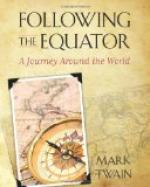A resident told me that those were not mountains; he said they were rabbit-piles. And explained that long exposure and the over-ripe condition of the rabbits was what made them look so blue. This man may have been right, but much reading of books of travel has made me distrustful of gratis information furnished by unofficial residents of a country. The facts which such people give to travelers are usually erroneous, and often intemperately so. The rabbit-plague has indeed been very bad in Australia, and it could account for one mountain, but not for a mountain range, it seems to me. It is too large an order.
We breakfasted at the station. A good breakfast, except the coffee; and cheap. The Government establishes the prices and placards them. The waiters were men, I think; but that is not usual in Australasia. The usual thing is to have girls. No, not girls, young ladies—generally duchesses. Dress? They would attract attention at any royal levee in Europe. Even empresses and queens do not dress as they do. Not that they could not afford it, perhaps, but they would not know how.
All the pleasant morning we slid smoothly along over the plains, through thin—not thick—forests of great melancholy gum trees, with trunks rugged with curled sheets of flaking bark—erysipelas convalescents, so to speak, shedding their dead skins. And all along were tiny cabins, built sometimes of wood, sometimes of gray-blue corrugated iron; and the doorsteps and fences were clogged with children—rugged little simply-clad chaps that looked as if they had been imported from the banks of the Mississippi without breaking bulk.
And there were little villages, with neat stations well placarded with showy advertisements—mainly of almost too self-righteous brands of “sheepdip.” If that is the name—and I think it is. It is a stuff like tar, and is dabbed on to places where the shearer clips a piece out of the sheep. It bars out the flies, and has healing properties, and a nip to it which makes the sheep skip like the cattle on a thousand hills. It is not good to eat. That is, it is not good to eat except when mixed with railroad coffee. It improves railroad coffee. Without it railroad coffee is too vague. But with it, it is quite assertive and enthusiastic. By itself, railroad coffee is too passive; but sheep-dip makes it wake up and get down to business. I wonder where they get railroad coffee?
We saw birds, but not a kangaroo, not an emu, not an ornithorhynchus, not a lecturer, not a native. Indeed, the land seemed quite destitute of game. But I have misused the word native. In Australia it is applied to Australian-born whites only. I should have said that we saw no Aboriginals—no “blackfellows.” And to this day I have never seen one. In the great museums you will find all the other curiosities, but in the curio of chiefest interest to the stranger all of them are lacking. We have at home an abundance of museums, and not an American Indian in them. It is clearly an absurdity, but it never struck me before.




